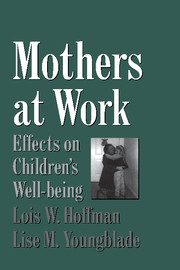Book contents
- Frontmatter
- Contents
- Preface
- 1 Introduction and Review of the Literature
- 2 Methodology
- 3 Children's Daily Family Lives: The After-School Day Interview
- 4 The Husband–Wife Relationship
- 5 The Mother's Well-being
- 6 Childrearing
- 7 Maternal Employment and Child Outcomes: The Direct Relationships
- 8 The Father's Role, Gender Attitudes, and Academic Outcomes
- 9 The Mother's Well-being and Child Outcomes
- 10 Childrearing Patterns and Child Outcomes
- 11 Nonmaternal Care and Supervision: Prevalence and Effects of Child-care Arrangements on Child Well-being
- 12 Summary and Overview
- Appendix: Measures Developed for This Study
- References
- Author Index
- Subject Index
4 - The Husband–Wife Relationship
Published online by Cambridge University Press: 06 July 2010
- Frontmatter
- Contents
- Preface
- 1 Introduction and Review of the Literature
- 2 Methodology
- 3 Children's Daily Family Lives: The After-School Day Interview
- 4 The Husband–Wife Relationship
- 5 The Mother's Well-being
- 6 Childrearing
- 7 Maternal Employment and Child Outcomes: The Direct Relationships
- 8 The Father's Role, Gender Attitudes, and Academic Outcomes
- 9 The Mother's Well-being and Child Outcomes
- 10 Childrearing Patterns and Child Outcomes
- 11 Nonmaternal Care and Supervision: Prevalence and Effects of Child-care Arrangements on Child Well-being
- 12 Summary and Overview
- Appendix: Measures Developed for This Study
- References
- Author Index
- Subject Index
Summary
We begin our analysis by examining the relationship between the mother's employment status and the role of the father in the family. This has been a topic of continuing interest in itself since the 1950s (Blood, 1963; Nye & Hoffman, 1963), and, in addition, consequences of maternal employment for children are often seen as operating through the effects on the father's role (see Chapter 1). The relationships to be examined here are illustrated in Figure 4.1. We will first take up the relationships between the mother's employment status and various aspects of the father's role in the family, particularly with respect to the division of household tasks and childrearing functions. Second, we will examine the relationships between maternal employment and the parents' gender-role attitudes. Third, we turn to the links between the father's role and the gender-role attitudes, and explore the possibility that the father's role mediates a maternal employment/gender-role attitude connection. Finally, we consider the complex relationships among maternal employment, father's role, and the marital satisfaction of each parent.
Sample
Because the focus here is on the role of the father in the household, the analysis in this chapter includes only two-parent families. A family was defined as two-parent if the mother had a male partner who had resided in the home for more than one year, and was considered part of the conjugal family by the mother.
- Type
- Chapter
- Information
- Mothers at WorkEffects on Children's Well-Being, pp. 76 - 102Publisher: Cambridge University PressPrint publication year: 1999

